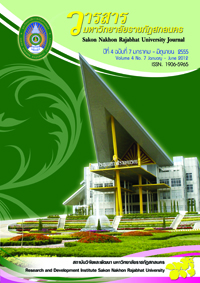การวิจัยเกี่ยวกับการใช้พลังอำนาจของผู้บริหาร
Abstract
บทคัดย่อ
พลังอำนาจเป็นกลไกสำคัญประการหนึ่งในการดำเนินงาน เพื่อให้บรรลุเป้าหมายขององค์การ ดังนั้น จึงเป็นสิ่งจำเป็นในการผลักดันการปฏิบัติงาน พลังอำนาจเป็นความสามารถของบุคคลหรือกลุ่มบุคคลที่มีอิทธิพลเหนือบุคคลอื่น ทำให้บุคคลอื่นเชื่อฟังและยินยอมปฏิบัติตาม โดยมีแหล่งฐานที่มาอยู่ 7 แหล่ง ได้แก่ พลังอำนาจจากการให้รางวัล พลังอำนาจจากการบังคับ พลังอำนาจจากการเชี่ยวชาญ พลังอำนาจตามกฎหมาย พลังอำนาจจากการอ้างอิง พลังอำนาจจากข่าวสาร และพลังอำนาจจากการพึ่งพา วิธีการในการสร้างพลังอำนาจในองค์การ ได้แก่ การแลกเปลี่ยนผลประโยชน์ การเอามาเป็นพวก การสร้างพันธมิตร การมีอิทธิพลในการกำหนดเกณฑ์ การควบคุมข้อมูล การให้บริการพิเศษ แนวทางการวิจัยเกี่ยวกับการใช้พลังอำนาจของผู้บริหารมี 3 ลักษณะ ได้แก่ การศึกษาการใช้พลังอำนาจของผู้บริหารในการบริหารงาน การเปรียบเทียบการใช้พลังอำนาจของผู้บริหาร การศึกษาความสัมพันธ์ระหว่างตัวแปร หรือส่งผลต่อตัวแปรอื่น ๆ
Abstract
Power is a key of administration to assist the organizations to achieve the goals. Therefore, it can be said that power is necessary for administration. Power is the ability of individual or groups of people who influence over others and make others compliant. To make others compliant, it is necessary to focus on where power stems from. There are seven sources of power need to be focused on, which are Reward power, Coercive power, Legitimate power, Expert power, Referent power, Information power, and Connection power. In addition, the power acquiring in organization consists of benefit exchange, team making, alliance, influencing on policy making, information controlling, and special services. Moreover, there are three of research directions on power of administrators, which are the study of power of administration, the comparison of power of administrators, and the study of relationships between variables.









